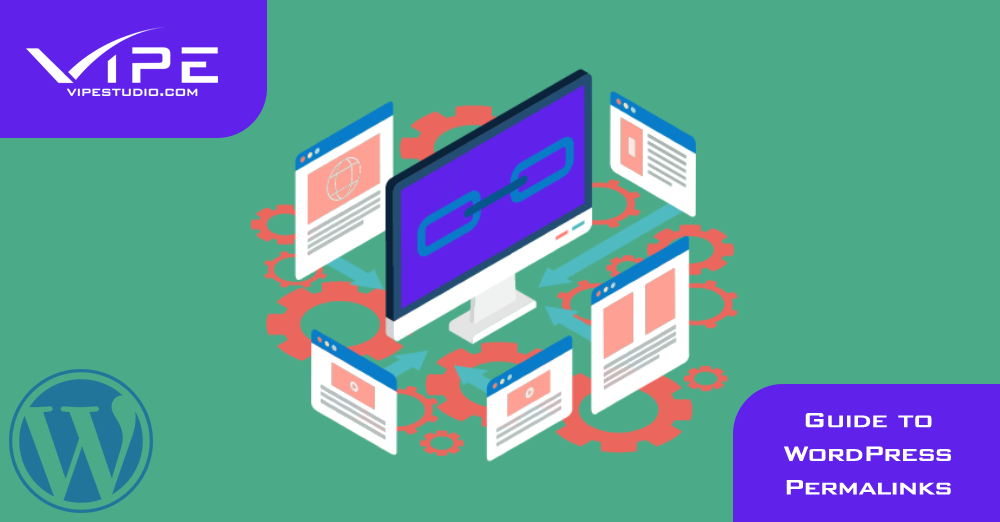13.12.2022
WordPress Development
Guide to WordPress Permalinks
READING TIME: MIN
Table of Content
Every page on your website has a distinct URL that lets users find it and access it easily.
These URLs should ideally be as simple to read and type as feasible. These particular URLs are referred to as permalinks or permanent links in technical jargon.
Based on the permalink structure you select, a Content Management System (CMS) like WordPress creates URLs for your pages and posts when you access them. It’s crucial to remember that some choices are more appropriate for readability and Search Engine Optimization (SEO).

What Are WordPress Permalinks
WordPress permalinks are, to put it simply, the distinctive URLs that the platform creates for each of your pages and posts. Consider these two permalinks as an illustration:
- vipestudio.com/en/custom-wordpress-development-8-major-benefits/
- vipestudio.com/en/?post=25552
Both serve to highlight the distinctive permalink structures. The first utilizes the blog post’s title as the slug, which is the part of the URL that designates a particular page.
The second example substitutes the post’s unique ID for its name as its slug.
Technically speaking, both URLs function in the same way. But it’s clear that the first strategy is considerably more approachable. In addition to being simpler to recall, it also explains to visitors what the page is about. The term “beautiful” permalink refers to this.
More significantly, employing keywords that describe the content of your page can aid search engines in comprehending it. In other words, it’s better in terms of SEO. You are losing out on organic traffic if you don’t use an optimal permalink structure.

The 6 Types of Permalink Structures in WordPress
Before we go any further, it’s crucial to understand that you should always set up your chosen link structure as soon as you create a new WordPress site. According to conventional wisdom, you should select your permalink structure during the first six months of your SEO development.
You can alter your permalink structure even if your website has been available for longer. However, if you don’t create redirects to your new URLs, it could negatively affect your search engine rankings.
In light of this, we’ll assist you in choosing the ideal framework for your WordPress website.
1. ID Number
This permalink structure was already demonstrated to you above. Another illustration to help you remember:
- exampleofsite.com/?p=121
This building is only a skeleton, as its name suggests. The allocated ID of a page from your database is actually the slug. It offers no details regarding the page you are seeing. Most of the time, you’ll want to employ a structure that gives your visitors and search engines a little bit more information.
2. Day and Name
This permalink structure, as the name implies, incorporates the date and title of your page or post into the URL. Here’s an illustration:
- examplewebsite.dev/2022/08/25/example-post/
This structure has the advantage of informing your users how old the post is. Without having to look for the date in the text, in some circumstances, this can assist them in determining whether the information is still pertinent. This structure is frequently used by news and magazine websites, in other words, by any website that produces time-specific material.
The practice of dating your postings has drawbacks as well. Imagine, for instance, that you have a superb publication that was released two years ago and is regarded as the best source of knowledge on a specific subject.
Some readers might simply glance at the date and conclude that this advice is no longer applicable, whether or not it is.
To be clear, it’s usually a good idea to mention the post’s publishing date somewhere in it, but there’s no good need to include it in the URL.

3. Month and Name
The structure of this permanent bond is very similar to the one we just examined. The day of the post is not part of the URL, which is the sole difference.
- examplewebsite.dev/2022/08/example-post/
From a functional standpoint, we face the same set of advantages and disadvantages as the “Day and Name” arrangement. While being able to tell how old a post or page is at a glance might be helpful for readers, it can also make some of your content appear outdated.
4. Numeric
The numerical permanent bond structure resembles the “Flat” option in many ways. To demonstrate this arrangement in action, let’s look at a URL:
- examplewebsite.com/files/121
Similar to Flat permalinks, this configuration uses the ID of your post as its slug and gives users no more information. You also receive a short permalink in this instance, but there are no further benefits, therefore it shouldn’t be your top choice.
5. Publication Name
This is one of our preferred WordPress permalink structures. Use the names of your posts and pages to identify them, which will produce a clear and memorable URL like:
- websiteexample.com/your-best-post
The beautiful thing about this is that you can give your pages and articles whatever names you want, and if those titles end up being too long, you can even change the slugs.
Your slug should, as a general rule, only contain 3-5 words. This manner, it’s still too long for your visitors to remember while also making it simple for search engines to figure out what the piece is about.

6. Custom Structure
WordPress also enables you to create your own structures if none of the ones we have discussed thus far have persuaded you. If you operate a blog, for instance, you could create distinct categories for your summaries and reviews and reference those in your links.
Here’s an illustration:
- websiteexample.com/top-list/x-best-plugins-2022
WordPress actually gives you ten structure tags that you may utilize to create unique permalinks.
Taking Help From a Professional Enterprise WordPress Agency for Development for WordPress-Related Issues
When it comes to WordPress development, it is important to have a professional Enterprise WordPress Agency for Development on your side. An Enterprise WordPress Agency for Development will be able to provide you with the best possible support and guidance when it comes to developing your website.
This is because the Enterprise WordPress Agency for Development will have years of experience in the field. An Enterprise WordPress Agency for Development will be able to guide you through every step of the development process, ensuring that your website reaches its full potential.
Additionally, an Enterprise WordPress Agency for Development will be able to offer you a wide range of services, including: WordPress development, Theme Development, Website Design, Website Maintenance, etc.

Best Enterprise WordPress Agency for Development
If you are looking for an Enterprise WordPress Agency for Development that can help you develop your website the right way, then Vipe Studio is a perfect choice.
We have years of experience in the industry, and our team is composed of experts who will work with you to create a site that meets your specific needs. Plus, we are focused on building long-term partnerships, so you can be sure that you’re making the best possible decision by choosing Vipe Studio as your development partner.
More on The Topic
- Scaling WordPress Without Losing Culture
- WordPress 6.9 “Gene”: What This Release Really Changes
- Managing Gutenberg Chaos at Scale
- The Real Difference Between Managed and Developer-Oriented Hosting
- WordCamp Sofia 2025: A Full Recap of Bulgaria’s Biggest WordPress Event
Tags: permalinkstips and tricksurlwordpress website
The content of this website is copyrighted and protected by Creative Commons 4.0.



